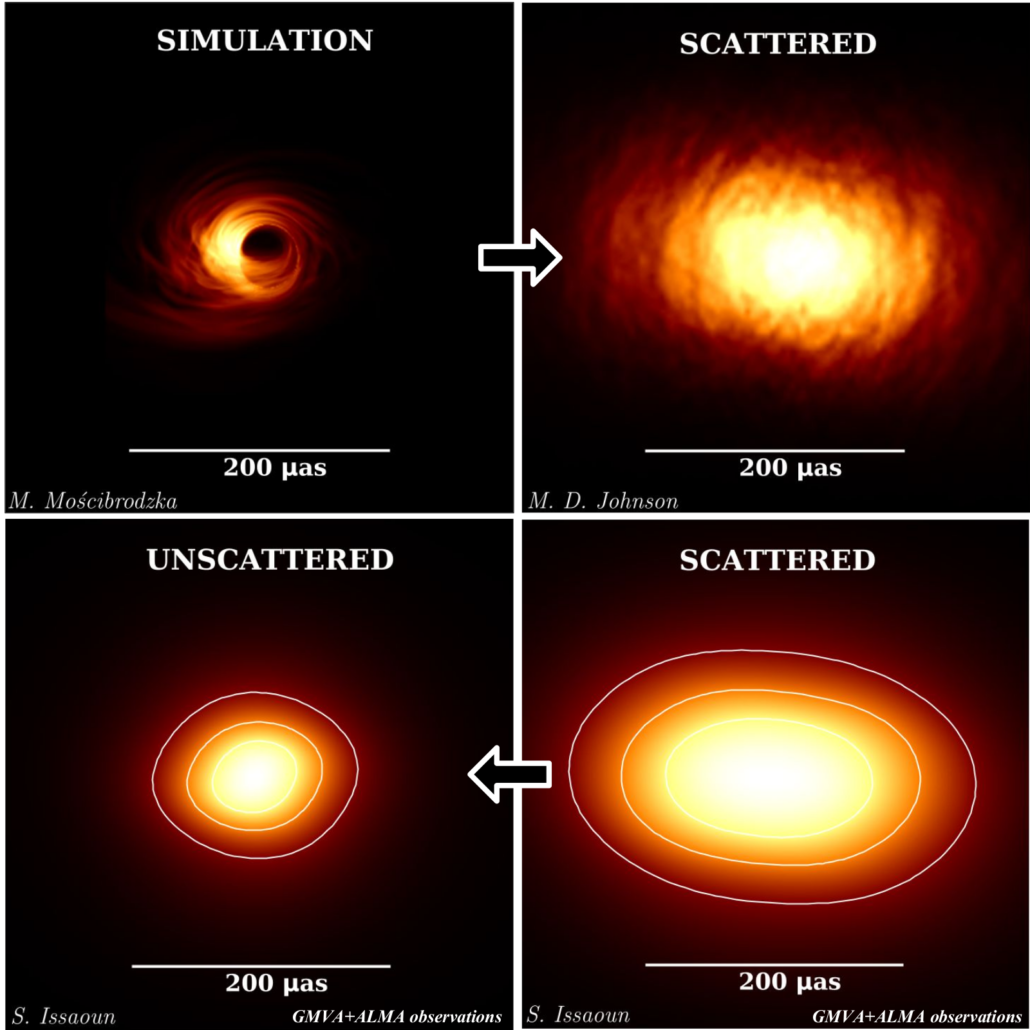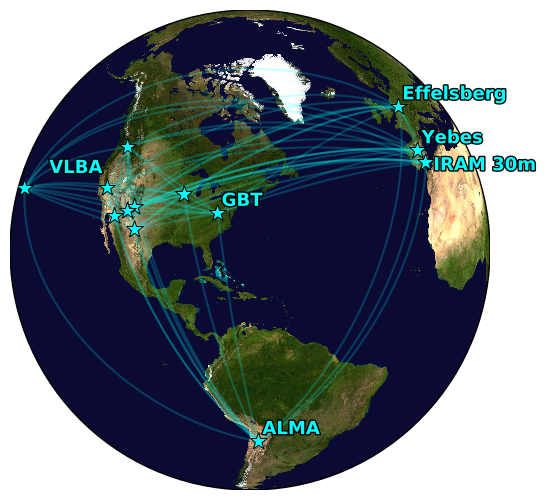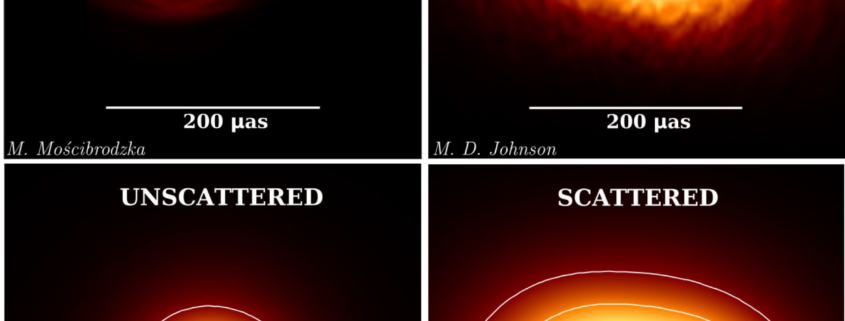Including the powerful ALMA into an array of telescopes for the first time, astronomers have found that the emission from the supermassive black hole Sagittarius A* (Sgr A*) at the center of our Galaxy comes from a smaller region than previously thought. This may indicate that a radio jet from Sgr A* is pointed almost toward us. The paper, led by the Nijmegen PhD student Sara Issaoun, is published in the Astrophysical Journal.
So far, a foggy cloud of hot gas has prevented us from making sharp images of the supermassive black hole Sgr A* and causing doubt on its true nature. Astronomers have now included for the first time the powerful ALMA telescope in northern Chile into a global network of radio telescopes to peer through this fog, but the source keeps surprising them: its emission region is so small that the source may actually have to point directly at us.
Observing at a frequency of 86 GHz with the technique of Very Long Baseline Interferometry (VLBI), which combines many telescopes to form a virtual telescope the size of the Earth, the team succeeded in mapping out the exact properties of the light scattering blocking our view of Sgr A*. The removal of most of the scattering effects has produced a first image of the surroundings of the black hole.

The high quality of the unscattered image has allowed the team to constrain theoretical models for the gas around Sgr A*. The bulk of the radio emission is coming from a mere 300 millionth of a degree, and the source has a symmetrical morphology. “This may indicate that the radio emission is produced in a disk of infalling gas rather than by a radio jet,” explains Issaoun, who has tested several computer models against the data. “However, that would make Sgr A* an exception compared to other radio emitting black holes. The alternative could be that the radio jet is pointing almost at us.”
Issaoun’s supervisor Heino Falcke, Professor of Radio Astronomy at Radboud University, calls this statement very unusual, but he also no longer rules it out. Last year, Falcke would have considered this a contrived model, but recently the GRAVITY team came to a similar conclusion using ESO’s Very Large Telescope Interferometer of optical telescopes and an independent technique. “Maybe this is true after all”, concludes Falcke, “and we are looking at this beast from a very special vantage point.”
Supermassive black holes are common in the centers of galaxies and may generate the most energetic phenomena in the known universe. It is believed that, around these black holes, matter falls in a rotating disk and part of this matter is expelled in opposite directions along two narrow beams, called jets, at speeds close to the speed of light, which typically produces a lot of radio light. Whether the radio emission we see from Sgr A* comes from the infalling gas or the outflowing jet is a matter of intense debate.
Sgr A* is the nearest supermassive black hole and ‘weighs’ about 4 million solar masses. Its apparentsize on the sky is less than a 100 millionth degree, which corresponds to the size of a tennis ball on the moon as seen from the Earth. To measure this, the technique of VLBI is required. The resolution achieved with VLBI is further increased by the observation frequency. The highest frequency to date to use VLBI is 230 GHz. “The first observations of Sgr A* at 86 GHz date from 26 years ago, with only a handful of telescopes. Over the years, the quality of the data has improved steadily as more telescopes join,” says J. Anton Zensus, director of the Max Planck Institute for Radio Astronomy.
The research of Issaoun and international colleagues describes the first observations at 86 GHz in which ALMA also participated, by far the most sensitive telescope at this frequency. ALMA became part of the Global Millimeter VLBI Array (GMVA) in April 2017. The participation of ALMA, made possible by the ALMA Phasing Project effort, has been decisive for the success of this project.

“Sgr A* is located in the southern sky, thus the participation of ALMA is important not only because of its sensitivity but also because of its location in the southern hemisphere,” says Ciriaco Goddi, from the European ALMA Regional Center node in the Netherlands (ALLEGRO, Leiden Observatory). In addition to ALMA, twelve telescopes in North America and Europe also participated in the network. The resolution achieved was twice as large as in previous observations at this frequency and produced the first image of Sgr A* that iscompletely free of interstellar scattering (an effect caused by density irregularities in the ionized material along the line of sight between Sgr A* and the Earth).
To remove the scattering and obtain the image, the team used a technique developed by Michael Johnson of the Harvard-Smithsonian Center for Astrophysics (CfA). “Even though scattering blurs and distorts the image of Sgr A*, the incredible resolution of these observations allowed us to pin down the exact properties of the scattering,”says Johnson.“We could then remove most of the effects from scattering and begin to see what things look like near the black hole. The great news is that these observations show that scattering will not prevent the Event Horizon Telescope from seeing a black hole shadow at 230 GHz, if there’s one to be seen.”
Future studies at different wavelengths will provide complementary information and further observational constraints for this source, which holds the key to a better understanding of black holes, the most exotic objects in the known universe.
—————————————————————————————————-
More information? Contact:
- Sara Issaoun, Radboud University, Tel: +31 6 84526627, s.issaoun@astro.ru.nl
- Heino Falcke, Radboud University, Tel: +49 151 23040365, h.falcke@astro.ru.nl
Article:
The Size, Shape, and Scattering of Sagittarius A * at 86 GHz: First VLBI with ALMA: Issaoun, M. D. Johnson, L. Blackburn, C. D. Brinkerink, M. Mościbrodzka, A. Chael, C. Goddi, I. Martí-Vidal, J. Wagner, S. S. Doeleman, H. Falcke, T. P. Krichbaum, K. Akiyama, U. Bach, K. L. Bouman, G. C. Bower, A. Broderick, I. Cho, G. Crew, J. Dexter, V. Fish, R. Gold, J. L. Gómez, K. Hada, A. Hernández-Gómez, M. Janßen M. Kino, M. Kramer, L. Loinard, R.-S. Lu, S. Markoff, D. P. Marrone, L. D. Matthews, J. M. Moran, C. Müller, F. Roelofs, E. Ros, H. Rottmann, S. Sanchez, R. P. J. Tilanus, P. de Vicente, M. Wielgus, J. A. Zensus and G.-Y. Zhao.
Article reference: Issaoun, S., et al. 2019, ApJ, 871, 30 (https://doi.org/10.3847/1538-4357/aaf732).
Arxiv link: https://arxiv.org/abs/1901.06226
Astronomers from the BlackHoleCam team led and worked on the research.
The research team is also part of the EHT consortium, an international partnership of thirteen institutes from ten countries: Germany, the Netherlands, France & Spain (via IRAM), USA, Mexico, Japan, Taiwan, Canada and China (via EAO). http://www.eventhorizontelescope.org/
The participation of ALMA through the ALMA Phasing Project has been decisive for the success of this project. https://www.almaobservatory.org/
The data were correlated at the Max Planck Institute for Radioastronomy (MPIfR). Data analysis software was developed at the MIT Haystack Observatory and the Smithsonian Astrophysical Observatory.
This work is supported by the ERC Synergy Grant “BlackHoleCam: Imaging the Event Horizon of Black Holes”, Grant 610058. The National Science Foundation (AST-1126433, AST-1614868, AST-1716536) and the Gordon and Betty Moore Foundation (GBMF-5278) have provided financial support for this work. This work was supported in part by the Black Hole Initiative at Harvard University, which is supported by a grant from the John Templeton Foundation. The GMVA is partially supported by the European Union’s Horizon 2020 research and innovation programme under grant agreement No 730562 (RadioNet).
This press release was originally posted at https://www.ru.nl/astrophysics/news-agenda/news/news-ru/lifting-veil-black-hole-heart-our-galaxy/






